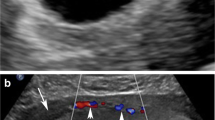Abstract
Purpose
To evaluate clinical outcomes of pelvic artery embolization (PAE) for treatment of obstetric hemorrhage, and determine the predictive factors associated with failure.
Materials and Methods
This retrospective study included all consecutive patients who underwent PAE for obstetric hemorrhage (not only in the post-partum setting), between January 2003 and January 2013 at three tertiary care centers. Medical records and imaging were reviewed to identify the study population and collect data on patient characteristics, PAE characteristics, and outcomes. Multiple parameters were compared between the failed and successful PAE groups, and univariate analysis was performed to determine the predictive factors for PAE failure.
Results
A total of 74 PAE procedures were performed in 68 patients. Primary clinical success rate was 78 %. On univariate analysis, three factors were associated with PAE failure: hemodynamic instability (p < 0.022), hemoglobin level <95 g/dL (p < 0.024), and disseminated intravascular coagulation (DIC) (p < 0.046). Other factors, including maternal characteristics, antecedent history, angiographic finding, embolic agent, operator experience, procedure done after hours, and unilateral versus bilateral embolization, did not show any statistically significant association with PAE failure. Only one major complication was encountered, which was fetal demise in a pregnant patient with a uterine arteriovenous malformations. Out of the 68 patients, there were 61 total pregnancies at follow-up.
Conclusion
PAE is an effective treatment for obstetric hemorrhage, with a low complication rate, and preserves fertility. Factors significantly associated with PAE failure include hemodynamic instability, hemoglobin level <95 g/dL, and DIC.



Similar content being viewed by others
References
Pelage P, Dref O, Mateo J, Soyer P, Jacob D, Kardache M. Life threatening primary postpartum hemorrhage: treatment with emergency selective arterial embolisation. Radiology. 1998;208:359–62.
Lopera J, Suri R, Kroma GM, Garza-Berlanga A, Thomas J. Role of interventional procedures in obstetrics/gynecology. Radiol Clin North Am. 2013;51(6):1049–66.
Hwang SM, Jeon GS, Kim MD, Kim SH, Lee JT, Choi MJ. Transcatheter arterial embolisation for the management of obstetric haemorrhage associated with placental abnormality in 40 cases. Eur Radiol. 2013;23(3):766–73.
Poujade O, Zappa M, Letendre I, Ceccaldi PF, Vilgrain V, Luton D. Predictive factors for failure of pelvic arterial embolization for postpartum hemorrhage. Int J Gynaecol Obstet. 2012;117(2):119–23.
Sidhu HK, Prasad G, Jain V, Kalra J, Gupta V, Khandelwal N. Pelvic artery embolization in the management of obstetric hemorrhage. Acta Obstet Gynecol Scand. 2010;89(8):1096–9.
Lee HY, Shin JH, Kim J, et al. Primary postpartum hemorrhage: outcome of pelvic arterial embolization in 251 patients at a single institution. Radiology. 2012;264(3):903–9.
Kim YJ, Yoon CJ, Seong NJ, et al. Failed pelvic arterial embolization for postpartum hemorrhage: clinical outcomes and predictive factors. J Vasc Interv Radiol. 2013;24(5):703–9.
Taylor FB Jr, Toh CH, Hoots WK, et al. Towards definition, clinical and laboratory criteria, and a scoring system for disseminated intravascular coagulation. Thromb Haemost. 2001;86:1327–30.
Maleux G, Timmerman D, Heye S, Wilms G. Acquired uterine vascular malformations: radiological and clinical outcome after transcatheter embolotherapy. Eur Radiol. 2006;16(2):299–306.
Winograd RH. Uterine artery embolization for postpartum hemorrhage. Best Pract Res Clin Obstet Gynaecol. 2008;22(6):1119–32.
Soyer P, Morel O, Fargeaudou Y, et al. Value of pelvic embolization in the management of severe postpartum hemorrhage due to placenta accreta, increta or percreta. Eur J Radiol. 2011;80(3):729–35.
Touboul C, Badiou W, Saada J, et al. Efficacy of selective arterial embolisation for the treatment of life-threatening post-partum haemorrhage in a large population. PLoS ONE. 2008;3(11):e3819.
Lee HY, Shin JH, Kim J, et al. Primary postpartum hemorrhage: outcome of pelvic arterial embolization in 251 patients at a single institution. Radiology. 2012;264(3):903–9.
Rossi AC, Lee RH, Chmait RH. Emergency postpartum hysterectomy for uncontrolled postpartum bleeding: a systematic review. Obstet Gynecol. 2010;115:637–44.
Bros S, Chabrot P, Kastler A, et al. Recurrent bleeding within 24 hours after uterine artery embolization for severe postpartum hemorrhage: are there predictive factors? Cardiovasc Intervent Radiol. 2012;35(3):508–14.
Ghai S, Rajan DK, Asch MR, Muradali D, Simons ME, TerBrugge KG. Efficacy of embolization in traumatic uterine vascular malformations. J Vasc Interv Radiol. 2003;14(11):1401–8.
Singh N, Tripathi R, Mala YM, Tyagi S, Tyagi S, Singh C. Varied presentation of uterine arteriovenous malformations and their management by uterine artery embolisation. J Obstet Gynaecol. 2014;34(1):104–6.
Gaia G, Chabrot P, Cassagnes L, et al. Menses recovery and fertility after artery embolization for PPH: a single-center retrospective observational study. Eur Radiol. 2009;19(2):481–7.
Acknowledgments
We would like to acknowledge the support of the interventional radiology department across our three hospitals, including the radiologists, nurses, technologists, and administrative department, especially Tracey Clare (Research coordinator, University of Alberta Diagnostic Imaging), and Linda O’Hara (Manager of Diagnostic Imaging at University of Alberta Hospital). No grant was utilized for this research.
Conflict of interest
Dr. Edwin Zhang: No potential conflict of interest to declare; Mr. Lizhi Liu: No potential conflict of interest to declare; Dr. Richard Owen: No potential conflict of interest to declare.
Informed consent
Our study protocol was approved by our institutional review board, and informed consent was waived.
Author information
Authors and Affiliations
Corresponding author
Rights and permissions
About this article
Cite this article
Zhang, E., Liu, L. & Owen, R. Pelvic Artery Embolization in the Management of Obstetrical Hemorrhage: Predictive Factors for Clinical Outcomes. Cardiovasc Intervent Radiol 38, 1477–1486 (2015). https://doi.org/10.1007/s00270-015-1092-5
Received:
Accepted:
Published:
Issue Date:
DOI: https://doi.org/10.1007/s00270-015-1092-5




